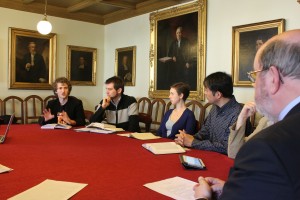For Part 1 of this series, see here.
Theresa Heilig and Christoph Heilig: Historical Methodology
A few essays further into the book – in the midst of the section on “Methodological Issues” – Theresa and I address specifically the historical methodology employed by Wright in his reconstruction of Paul’s activity (in the broadest sense).
In a certain sense, this essay (you can get a glimps at it here) – written from the perspective of the philosophy of historiography (GFP 116) – can be “located in the middle of the web of many of the other contributions” in God and the Faithfulness of Paul (GFP 117). This means that Andreas Losch deals with the more fundamental issue of the perception of reality in general, while other chapters (still in the “methodological” section) address the parameter of evidence itself – such as the chapter by Eve-Marie Becker on Acts. Our analysis, by contrast, is “located between this evidence itself and Wright’s conclusions that are reached on the basis of this evidence.” In other words, “we are investigating the inferential structure that bridges evidence and Wright’s exegetical and theological theses” – which are then discussed in the many contributions that follow later in the book (GFP 117). (Cf. the TOC here.)
As point of departure for our analysis (GFP 117), we choose Wright’s explicit statement (PFG xviii) that his “attempt to make sense of [the ‘facts’] through forming hypotheses and then testing them against the evidence” can be categorized as abduction or inference to the best explanation. Further, Wright himself identifies the philosopher Charles S. Peirce as the originator of this conception (PFG xviii). Since this is how abduction is usually introduced and since this is the terminology most readers are most probably familiar with, we also introduce this mode of inference (GFP 118-121) in relation to “deduction” and “induction,” using the example of driving in a car with flat tire (so the hypothesis, at least), provided by Wright himself in The New Testament and the People of God (p. 43). Wright himself stresses that central to the process of abduction is the formation of causal stories that function as explanations for observed evidence. Hence, we begin our assessment of Wright’s approach by asking (building largely on the work of Peter Lipton) what characteristics something needs to display in order to count as an “explanation” (GFP 121-125). Here, it should become obvious for the first time that these philosophical considerations are not merely an abstract discussion without any bearing on exegesis itself. We explicitly take up Moyise’s (GFP 179) and Wischmeyer’s (GFP 97-98) critical question of whether Wright’s references to worldview and narrative sub-structures really explain the text that Paul wrote (GFP 122-125). Though exegetes are usually not aware of this fact, the correct answer to this question is based to a significant extent on the notion of explanation that is presupposed.
In the next large section (GFP 125-136) we set ourselves a difficult task: Since Peirce had introduced the concept of abduction, the philosophical discussion has moved on, shifting the focus largely from the area of “discovery” to the issue of “confirmation.” What complicates matters is not only this shift in the kind the question is posed but also the fact that the latter perspective is also already hinted at by Peirce himself, whose own conception evolved over time (GFP 125-127). Similarly, Wright also speaks not only about the “forming [of] hypotheses” but also about their subsequent “testing … against the evidence” (PFG xviii). It is this latter issue where most of recent debate has taken place in relation to the validity of the mode of abduction: Building on a mathematical theorem named after Thomas Bayes (1701-1761), one can prescribe how the probability of a hypothesis ought to be calculated on the basis of what is called the “prior-probabilities” of competing hypothesis (the probabilities of hypotheses before the new evidence is taken into account) and the probabilities of the evidence that has been observed under the presupposition that the hypotheses were true (confusingly called “likelihoods”). If you are not familiar with Bayes’s Theorem yet, grab coffee and watch this short video, which promises to explain it “like you’re five” and is really entertaining.
In relation to abduction, this approach creates problems depending on how one defines an explanation as being the “best” and how one relates this to the idea of the probability of a hypothesis (cf. GFP 127-131). Certain accounts of abduction seem to be more vulnerable to the challenges of confirmation theory than others. Although Wright never develops his notion of abduction in that regard explicitly, one can deduce – pun intended – certain features of the inferential structures he presupposes. As this analysis confirms – just to push this wordplay a little too far – Wright “seems to offer something of a compatibilist account” of abduction (GFP 134; for the analysis itself, see GFP 131-134). This might sound like hairsplitting to most working on a more pragmatic level with Pauline texts and other historical evidence. However, it has the very significant implication that where Wright makes an argument – i.e., virtually everywhere where he comes to an exegetical or biographical decision concerning Paul and his letter writing – it “should be compatible with the structure of Bayes’s Theorem” (GFP 134).
This means that we – finally, after quite a bit of theoretical considerations – we can now evaluate Wright’s actual methodological framework. We note that there are two possible strategies for doing so: Wright specifies certain “criteria” a good hypothesis should meet (e.g., “simplicity”) and one could enter the discussion of whether “simplicity” is really an indicator of probability (cf. GFP 134-135). However, the discussion of these “explanatory virtues” is very confusing on its own, and it would be even more difficult to ascertain how Wright’s notions fit in there (136). Furthermore, Wright usually does not make recourse to these criteria in his argumentation so that it seems wiser to us to “investigate Wright’s actual inferential praxis – that is, what aspects he considers in reaching conclusions, how this relates to a Bayesian framework, and where it might be improved” (GFP 136). If you have become interested in this question by now (as we hope you have) and if you have come to the conclusion that this theoretical blah-blah might actually yield some interesting results (as we are confident that you have), then you have to buy the book to see how we develop these thoughts in GFP 136-149.
In particular, we address the following aspects:
- How do Wright’s statements concerning the disputed Pauline letters relate to these foundations discussed by us? What impact does GFP as a whole have on this issue, given that it mentions the question of authenticity only shortly? And how do scholars who disagree with Wright’s judgements need to react to his position in order to present valid arguments? (GFP 136-139)
- Very foundationally, does Wright’s idiosyncratic talk about “worldviews” make any sense from a methodological perspective? (GFP 139-140)
- More specifically, does Wright offer the evidence that is necessary to tip the balance of the probabilities of hypotheses in favor of Scriptural allusions in specific Pauline verses? (GFP 141-142)
- Can it be demonstrated that Wright misses important data in his worldview description so that his exegetical decisions lack substantiation by certain kinds of evidence? In particular, does he overemphasize cognitive aspects of the person at the cost of everyday experiences and how might this influence his interpretation of Paul? (GFP 142-144)
- Might it be problematic that Wright directly contrasts Paul’s mindset with an early-Jewish worldview but does not address in detail the “missing link” of the early Christian worldview in general? (GFP 144-145)
- While stories are a vital part of explaining evidence, is it possible that Wright’s focus on them leads him to complicate some of his interactions with other scholars instead of providing structures that make the dialogue more accessible? In particular, how could his debate with John Barclay in Ch. 12 of PFG be improved if it followed the basic structure of Bayes’s Theorem in the way the argument is presented? (GFP 145-158).
Stay tuned for the third, and final, part of this series!
Christoph Heilig is working on an SNF-Project on “Narrative-Substructures in the Letters of Paul” with Prof. Jörg Frey. He is the author of Hidden Criticism? Methodology and Plausibility of the Search for a Counter-Imperial Subtext in Paul, WUNT II 392 (Tübingen: Mohr Siebeck, 2015) and Paul’s Triumph: Reassessing 2 Corinthians 2:14 in Its Literary and Historical Context, BTS 27 (Leuven: Peeters, 2016).



7 Kommentare vorhanden
1 Zurich Engages Wright | Larry Hurtado's Blog // Sep 24, 2016 at 11:26
[…] by Benjamin Schliesser, here. The second posting focuses on Wright’s historical methodology here. The third posting features the critique of Wright’s view of “apocalyptic” […]
2 Frederik Mulder // Dec 20, 2016 at 16:57
Your Bayesian considerations provide a helpful and systematic framework to analyse and critique Wright’s big picture grand narrative schemes, as well as the details he focusses on in order to validate his big picture claims. You did meticulous work which must’ve taken a long time (your wife helped!). The extra nice thing is that one will now be able to use your Bayesian considerations as framework for assessing numerous other issues in PFG!
3 Early Christians and Their Caesars // Feb 1, 2017 at 19:08
[…] Recent years have seen a steadily growing interest in the question of how the parameters of society in the Roman Empire influenced the communities behind the New Testament texts and their respective authors. While some have argued that the NT texts indeed display critical interaction with this Roman sphere, others are more critical of assuming such conflicts and the idea that they are a kind of hermeneutical key for understanding the early Christians. This debate is probably best exemplified by the debate between N. T. Wright and John M. G. Barclay (which Theresa and I have analysed in an essay that has been discussed on this blog here). […]
4 Paul’s Triumph // Feb 2, 2017 at 9:48
[…] with Theresa Heilig, I’ve written an extensive introduction to abductive and Bayesian reasoning and I do not want to repeat these considerations here. What I would like to point out is the fact […]
5 On Ancient Languages // Feb 23, 2017 at 13:49
[…] shown on the basis of considerations from the field of the philosophy of science (see for this the essay I co-authored with Theresa Heilig) that in order to determine how a word is used in a NT passage, […]
6 New Editions of “God and the Faithfulness of Paul”! // Apr 5, 2017 at 14:06
[…] can find summaries of the essays that were contributed by our department on this blog (see here, here, and […]
7 Are There Anti-Imperial “Echoes” in Paul’s Letters? // Sep 13, 2017 at 9:55
[…] that would make it very probable if it were true. Together with Theresa Heilig, I have argued elsewhere that this is a potential danger of proposals that rely on “abduction.” For example, it stands […]
Kommentar schreiben